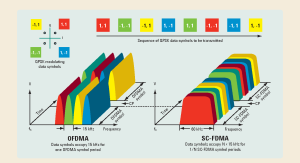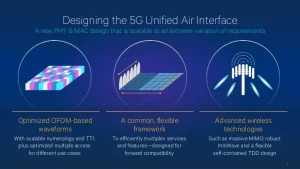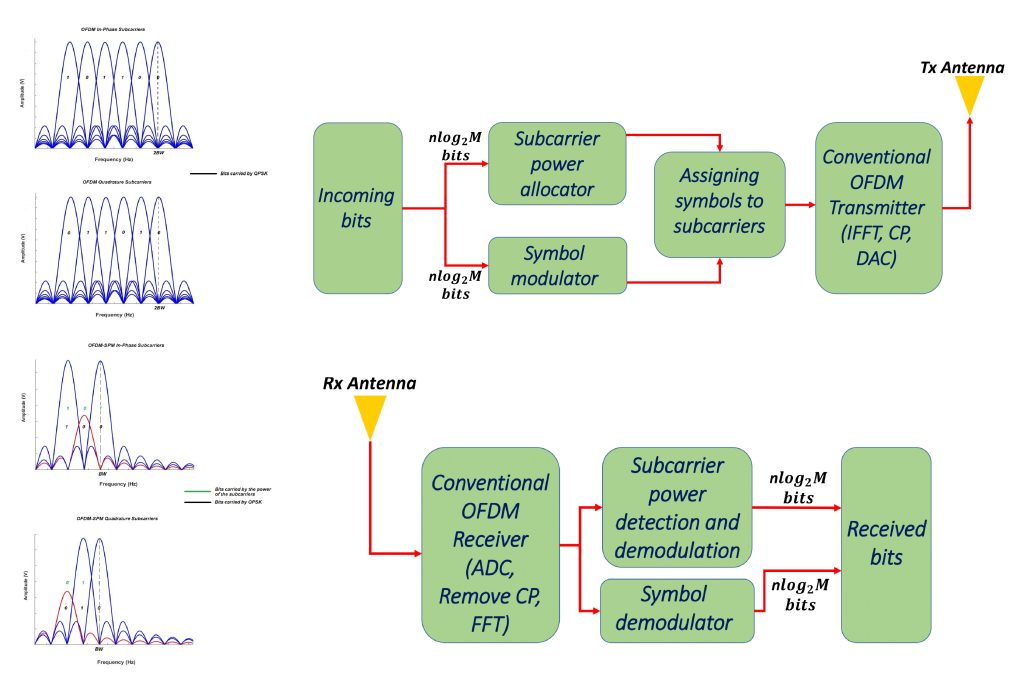OFDM, a digital modulation technique utilized in wireless communication systems, stands out from other multiplexing techniques. While time-division and frequency-division multiplexing allocate different time slots or frequencies to multiple signals, OFDM divides the available bandwidth into numerous subcarriers that carry a portion of the data.

What’s intriguing about OFDM is its ability to mitigate interference caused by reflections and signal fading in wireless channels. By spreading data across numerous subcarriers, it can selectively cancel out any interfering signals on specific subcarriers without affecting others. This characteristic makes it particularly useful for high-speed data transmission over long distances in noisy environments.
Another fascinating aspect of OFDM is its spectral efficiency and bandwidth utilization. With each subcarrier carrying only a small amount of data, many more subcarriers are available than with traditional single-carrier modulation schemes. As such, this allows for more efficient use of the available spectrum and higher overall throughput.
On the flip side though, using OFDM requires complex equalization algorithms to compensate for inter-symbol interference between adjacent subcarriers caused by channel distortion or non-linearities in amplifiers – making it somewhat complicated to implement at times. Moreover, since OFDM employs a large number of narrowband carriers instead of a few wideband ones like some other modulations do; these may not be suitable applications where low latency or real-time response times are critical due to processing overheads involved with handling all those carriers simultaneously when transmitting data on an ongoing basis over extended periods without interruption at high rates per second (bps).
The advantages of OFDM in wireless communication systems
Contents
- 1 The advantages of OFDM in wireless communication systems
- 2 The disadvantages of other multiplexing techniques in comparison to OFDM
- 3 The advantage of OFDM in data transmission with high data rates
- 4 The importance of equalization in OFDM systems and its impact on interference
- 5 The advantages of OFDM in terms of spectral efficiency and bandwidth utilization
- 6 The use of OFDM in adaptive modulation and coding techniques
- 7 The various variants of OFDM and its applications in the wireless market place.
Orthogonal Frequency Division Multiplexing (OFDM) has rapidly gained popularity in wireless communication systems due to its remarkable benefits. OFDM is an exceptional multiplexing technique that employs multiple subcarriers for transmitting data concurrently, resulting in unprecedented data rates and improved spectral efficiency.

OFDM’s potential to combat interference is one of its most significant advantages. By segmenting the signal into numerous subcarriers, OFDM can proficiently counteract narrowband interference on individual carriers without affecting other carriers. Further enhancing the capabilities of interference rejection are equalization techniques employed in OFDM systems.
The flexibility of OFDM when used with various modulation schemes and coding techniques provides another advantage. The vector OFDM variant allows adaptive modulation and coding wherein transmission parameters adjust according to channel conditions. This results in optimal performance under fluctuating channel conditions while maintaining high data rates.
In conclusion, traditional single carrier techniques or other types of multiplexing such as time-division or frequency-division cannot compare with the numerous advantages offered by orthogonal frequency division multiplexing. With limited bandwidth resources available and a growing demand for high-speed wireless communications, it is no wonder that numerous modern wireless communication systems now employ some form of OFDM signal processing technology perplexingly bursting forth!
The disadvantages of other multiplexing techniques in comparison to OFDM
The multiplexing techniques of single carrier modulation schemes are plagued with numerous disadvantages that pale in comparison to OFDM. One of the most pressing issues is their inability to cope with frequency selective channels, which ravage narrowband communication systems and lead to subpar performance marked by a high bit error rate. On the flip side, OFDM leverages multiple carriers that have an uncanny aptitude for adapting to diverse channel conditions, making it more impervious against frequency-selective fading.
Another shortcoming of traditional multiplexing methods is their wasteful use of bandwidth. They often necessitate a significant guard interval between symbols to forestall interference brought about by intersymbol interference (ISI). This results in reduced spectral efficiency and heightened power consumption since amplifiers must expend more energy transmitting signals that bear larger guard intervals. However, OFDM sidesteps this issue by embracing shorter symbol durations while integrating cyclic prefixes instead of guard intervals.
Equalization represents yet another critical aspect where other multiplexing techniques woefully fall behind compared to OFDM’s cutting-edge technology. Equalization serves as compensation for mitigating the effects of channel distortion on transmitted signals before demodulation occurs at the receiving end. Nonetheless, traditional equalizers grapple with time-varying channels because they hinge on accurately estimating impulse response over time continually. In contrast, employing OFDM subcarriers reduces complexity due to each subcarrier experiencing flat fading; thus equalization becomes simpler and less computational than other approaches.
In conclusion, although wireless communication systems have employed other multiplexing techniques extensively over many years, they pale when weighed against the superior advantages offered by OFDM technology. Its lightning-fast adaptability under varying channel conditions without compromising bandwidth utilization or demanding complex equalization algorithms renders it an ideal solution for modern wireless networks today and tomorrow!
The advantage of OFDM in data transmission with high data rates
OFDM is a wireless communication technique that reigns supreme in high data rate transmission. Its superiority over other multiplexing techniques comes to light through its manifold advantages, one of them being the handling of frequency offset with ease. The use of orthogonal subcarriers with varying carrier frequencies enables OFDM to correct any frequency offset during demodulation without compromising the rest of the transmission.
Another perk that sets OFDM apart from other players in this game is its exceptional ability to achieve high spectral efficiency. This feat is accomplished by utilizing closely spaced subcarriers and applying coding and interleaving techniques, allowing for more information to be transmitted within a given bandwidth compared to other multiplexing techniques. Furthermore, since each subcarrier experiences less frequency selective fading than single-carrier systems due to channel selectivity spread across multiple carriers, overall performance improves dramatically.
Yet another layer of complexity arises when transmitting at high data rates using OFDM: managing peak-to-average power ratio (PAPR). Combining numerous subcarriers can result in significant peaks in signal strength as they may not always align perfectly in phase or amplitude during modulation. Managing these peaks requires careful consideration and implementation of various PAPR reduction techniques such as clipping or filtering. Despite this challenge, pairing adequate channel coding and interleaving alongside these PAPR reduction methods makes OFDM an excellent choice for achieving reliable wireless communication at high data rates nonetheless.
The importance of equalization in OFDM systems and its impact on interference
OFDM, the Orthogonal Frequency-Division Multiplexing technique has been gaining immense popularity in wireless communication systems owing to its spectrum of advantages. Indeed, one of its main benefits is high spectral efficiency which enables more effective use of available bandwidth. However, it’s crucial to note that OFDM requires adequate channel coding and interleaving techniques for symbol recovery lost due to selective fading than single-carrier systems.
In an OFDM system, each data stream undergoes subcarrier division into several orthogonal subcarriers. This reduces interference amidst these subcarriers resulting in higher data rates coupled with improved performance. But even with this advantage at bay, interference may still occur within a given OFDM symbol if there are timing or phase errors between the transmitter and receiver.
To mitigate such interferences, equalization techniques must be employed within an OFDM system. Equalization works by compensating for any distortions from multipath propagation or other factors ensuring signals arriving at the receiver are correctly interpreted. Through adaptive modulation and coding techniques alongside equalization methods like maximum likelihood estimation (MLE), Orthogonal Frequency Division Multiplexing can offer greater reliability and flexibility compared to other modulation schemes like Frequency Division Multiple Access (FDMA).
Overall, equalization plays a critical role in mitigating interference issues while improving overall signal quality; hence it cannot be overstated how important it is for an OFDM system’s success story. With proper implementation of equalization algorithms synergized with adequate channel coding and interleaving methods; achieving excellent performance becomes possible even under challenging conditions like those found in mobile environments where signal strength may vary significantly over time or distance traveled by radio waves through different mediums such as air or water etcetera!
The advantages of OFDM in terms of spectral efficiency and bandwidth utilization
The enigmatic and sporadic world of wireless communication has been revolutionized by the ubiquitous use of Orthogonal Frequency Division Multiplexing, commonly referred to as OFDM. This cutting-edge technique is renowned for its unparalleled ability to divide the channel into multiple narrowband signals, resulting in superior spectral efficiency and bandwidth utilization when compared with other antiquated multiplexing techniques that fail miserably in this regard.
OFDM’s unyielding nature also helps mitigate the effects of frequency selectivity, which can cause individual narrowband signals to suffer from flat fading. The widespread adoption of Filtered OFDM (COFDM) and Vector OFDM (VOFDM), two variants of this pioneering technology, have further cemented its place at the forefront of high data rate wireless systems due to their improved performance in noisy environments.
COFDM’s distinctive approach utilizes convolutional coding and interleaving methods to reduce errors caused by multi-path interference while VOFDM combines vector quantization with traditional OFDMA for enhanced signal quality. To add more mystery to an already perplexing topic, adaptive modulation and coding techniques are also included in the mix where transmission parameters are adjusted based on channel conditions. This allows for optimal use of available bandwidth without sacrificing signal quality or reliability.
Overall, there is no denying that using OFMD opens up a plethora of opportunities such as increased capacity, reduced interference from neighboring channels, and improved coverage range – making it an ideal choice for many wireless data applications today.
The use of OFDM in adaptive modulation and coding techniques
The essential nature of adaptive modulation and coding techniques in wireless communication systems is undeniable. OFDM technology presents a particularly suitable option for this purpose, as it divides channels into individually flat fading sub-channels. The appearance of interference on one or some of these sub-channels does not affect all the others, making OFDM an efficient coping mechanism for interference compared to other multiplexing techniques.
Moreover, data transmission in OFDM can be adapted to each specific bandwidth-limited sub-channel’s requirements. Redundancies from unaffected sub-channels help recover lost symbols due to interference in one channel. This simplifies channel equalization considerably since it only corrects errors affecting individual sub-carriers instead of the entire signal.
OFDM has several variants with diverse trade-offs between spectral efficiency and complexity depending on their applications in the wireless market place. Wavelet OFDM stands out among them since it uses wavelets instead of Fourier transforms for signal processing.
In summary, the use of OFDM technology within adaptive modulation and coding techniques offers significant advantages over other multiplexing options by dividing channels into flat fading sub-channels where only some are affected by interference, resulting in efficient coping mechanisms while optimizing bandwidth utilization through adaptation at each individual level without affecting others – even when dealing with complex signals encountered within various variants such as wavelet OFDM used today.
The various variants of OFDM and its applications in the wireless market place.
The enigmatic OFDM technology has taken the wireless market by storm, thanks to its unique ability to support a gamut of modulation schemes. The signal is comprised of multiple subcarriers that are tantalizingly modulated using different techniques like QPSK, 16-QAM or 64-QAM, resulting in an unparalleled efficiency in bandwidth utilization and spectral efficacy.
OFDM’s adaptability to fluctuating channel conditions is one of its most prominent advantages. With each subcarrier being indubitably equalized and customized according to the peculiarities of the channel characteristics, it enables adaptive modulation and coding (AMC) schemes which can dynamically adjust transmission rates based on changes in quality.
But wait! There’s more! OFDM also supports varied types of modulation schemes that make it possible for operation over diverse frequency bands and environments. It’s been used extensively in digital television broadcasting, Wi-Fi networks as well as cellular systems such as LTE or 5G NR – not forgetting satellite communications too!
Given this technology’s malleability and versatility, we anticipate a steady surge in its adoption across various industries down the line.


